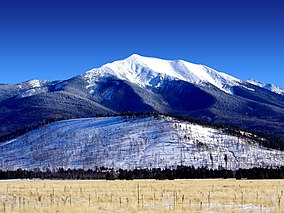Coconino National Forest
| Coconino National Forest | |
|---|---|
|
IUCN category VI (protected area with sustainable use of natural resources)
|
|

San Francisco Peaks, winter
|
|
|
Location in the United States
|
|
| Location | Coconino, Yavapai, and Gila counties, Arizona, USA |
| Nearest city | Flagstaff, Arizona |
| Coordinates | 34°55′N 111°32′W / 34.917°N 111.533°WCoordinates: 34°55′N 111°32′W / 34.917°N 111.533°W |
| Area | 1,856,038 acres (7,511.12 km2) |
| Established | July 2, 1908 |
| Visitors | roughly 1,890,000 (in 2004) |
| Governing body | U.S. Forest Service |
| Website | http://www.fs.usda.gov/coconino |
The Coconino National Forest is a 1.856-million acre (751,000 ha) United States National Forest located in northern Arizona in the vicinity of Flagstaff. Originally established in 1898 as the "San Francisco Mountains National Forest Reserve", the area was designated a U.S. National Forest in 1908 when the San Francisco Mountains National Forest Reserve was merged with lands from other surrounding forest reserves to create the Coconino National Forest. Today, the Coconino National Forest contains diverse landscapes, including deserts, ponderosa pine forests, flatlands, mesas, alpine tundra, and ancient volcanic peaks. The forest surrounds the towns of Sedona and Flagstaff and borders four other national forests; the Kaibab National Forest to the west and northwest, the Prescott National Forest to the southwest, the Tonto National Forest to the south, and the Apache-Sitgreaves National Forest to the southeast. The forest contains all or parts of ten designated wilderness areas, including the Kachina Peaks Wilderness, which includes the summit of the San Francisco Peaks. The headquarters are in Flagstaff. There are local ranger district offices in Flagstaff, Happy Jack, and Sedona.
Coconino is the word the Hopi use for Havasupai and Yavapai Indians. The Coconino National Forest was so named because it is located in the central portion of Coconino County.
...
Wikipedia

